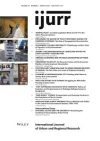Harvey’s (1978) switching theory has been widely used to theorize investments in the built environment. Crucially, in switching theory no distinction has been made between investments in the construction of the newly built environment and investments into the existing built environment. The distinction between these two types of switching is key to unveiling the relations between how value is produced, rents are extracted and interest payments are made as investments flow with the real estate sector, and the implications that such switching has for displacement. I discuss the distinction between different types of switching and the implications thereof by analysing the ebb and flow of investments in Spanish real estate from 2000 to 2007 and from 2014 to 2018. On the one hand, I claim that the two switching waves were qualitatively different in so far as capital was fixed in the built environment through the construction of new buildings between 2000 and 2007, whereas from 2014 to 2018 capital was fixed in existing buildings. In the first switching phase, value was produced and land rents were extracted, whereas the second switching phase was characterized mainly by rent extraction. On the other hand, the first switching moment entailed an increase in housing provision, whereas the second switching moment led to widespread displacement of the population.
Details
Written by:
Ismael Yrigoy
Digital Object Identifier (DOI)
https://doi.org/10.1111/1468-2427.13183
About DOI

